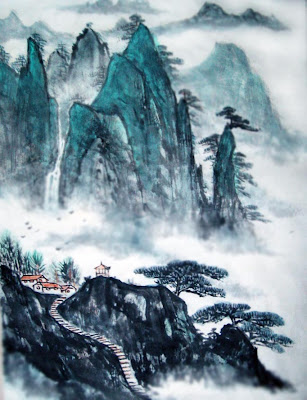Today we look at another Chinese character - "川", let us see whether you can guess its meaning by studying its evolution history: (image get from http://www.vividict.com)
Learn one Chinese Character a day - "川"
|
 is one of the Oracle script for "川". It looks like our modern roads with dotted lines to divide lanes. However there was no such concept in ancient China. Only till 秦始皇 (First Emperor of Qin Dynasty) came to power, he ordered his empire to produce carriages with standard width, then to construct roads referring to that size. That is very close to our modern concept of standard protocol for car sizes. When a carriage was built to that size, it was assured that it can be used all over the country. This is one of the highest achievement of 秦始皇 to China history. Another one is he unified the writing of Chinese characters. Both measurements (in Chinese 书同文,车同轨) result in tight union of Chinese people and economics.
is one of the Oracle script for "川". It looks like our modern roads with dotted lines to divide lanes. However there was no such concept in ancient China. Only till 秦始皇 (First Emperor of Qin Dynasty) came to power, he ordered his empire to produce carriages with standard width, then to construct roads referring to that size. That is very close to our modern concept of standard protocol for car sizes. When a carriage was built to that size, it was assured that it can be used all over the country. This is one of the highest achievement of 秦始皇 to China history. Another one is he unified the writing of Chinese characters. Both measurements (in Chinese 书同文,车同轨) result in tight union of Chinese people and economics. then is clearly NOT to mean road. Let us look at its components.
then is clearly NOT to mean road. Let us look at its components.  refers to the river side with standing rocks as its banks. And
refers to the river side with standing rocks as its banks. And refers to the torrent. The meaning of "川" is "small river with turbulent water flowing swiftly through valleys of mountains".
refers to the torrent. The meaning of "川" is "small river with turbulent water flowing swiftly through valleys of mountains".
In some Oracle script  is composed of river (
is composed of river ( ) and man (
) and man ( , which is a man
, which is a man with head downward to mean flowing down the river.). As you can see from "川" -
with head downward to mean flowing down the river.). As you can see from "川" - that river is one of the major transportation methods for ancient people living among mountains in China. And that is also why "川" is used to mean Drift and Travel. This meaning is however no longer frequently used except in some specific phrases like - "川资", where "资" means Capital. In total "川资" means the Capital for Travelling.
that river is one of the major transportation methods for ancient people living among mountains in China. And that is also why "川" is used to mean Drift and Travel. This meaning is however no longer frequently used except in some specific phrases like - "川资", where "资" means Capital. In total "川资" means the Capital for Travelling.
 is composed of river (
is composed of river ( ) and man (
) and man ( , which is a man
, which is a man with head downward to mean flowing down the river.). As you can see from "川" -
with head downward to mean flowing down the river.). As you can see from "川" - that river is one of the major transportation methods for ancient people living among mountains in China. And that is also why "川" is used to mean Drift and Travel. This meaning is however no longer frequently used except in some specific phrases like - "川资", where "资" means Capital. In total "川资" means the Capital for Travelling.
that river is one of the major transportation methods for ancient people living among mountains in China. And that is also why "川" is used to mean Drift and Travel. This meaning is however no longer frequently used except in some specific phrases like - "川资", where "资" means Capital. In total "川资" means the Capital for Travelling.
The amazing view of a 川 in China
|
Today we first time can enjoy a Chinese calligraphy with all Chinese characters learned - "四川". It refers to one of the provinces in China which has four major rivers within its borders.
Learn one Chinese Character a day - "川"
|
In traditional way of Chinese writing, the sequence is from top to bottom then right to left. It is because that Chinese ancestors wrote their articles on not paper but bamboo slices. Chinese calligraphy follows the traditional way.
 |
| Book wrote on bamboo |



























